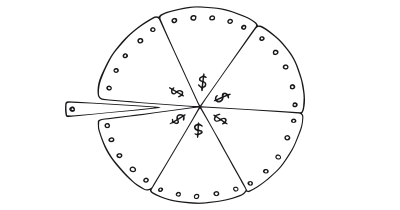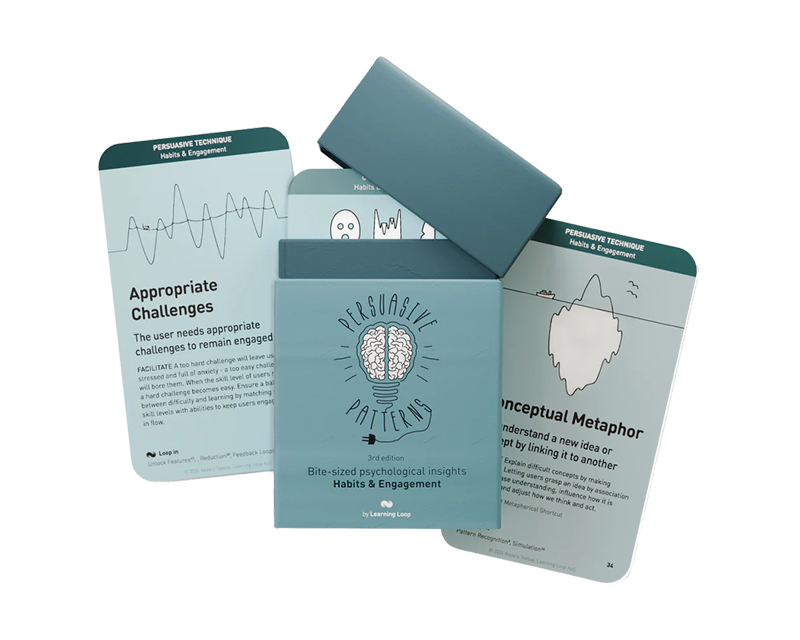Persuasive Patterns: Influence, Obligation
Commitment & Consistency
We want to appear consistent with our stated beliefs and prior actions

Commitment and Consistency refer to the psychological principle where individuals strive to be consistent with their past decisions, actions, or statements, especially after making an initial commitment.
Imagine walking in a neighborhood park when someone approaches with a clipboard in hand, asking for signatures to support a local environmental cause. Seeing that it’s a small gesture to help the environment, a person decides to sign the petition. A few weeks later, the same person is at home when they receive a knock at the door. The individual from the park, recognizing them, is now asking if they’d be willing to post a cardboard box on their front yard promoting the cause. Having already expressed their support once by signing the petition, the individual feels an internal pressure to remain consistent with their prior commitment and is more inclined to agree to the new request.
Consider an individual exploring a new fitness app for the first time. Shortly after they sign up, a pop-up appears asking if they’d like to share their fitness goals with the community. They decide to publicly post: “Hoping to run my first 5k in the next two months!” This declaration, while minor, is now visible to the app’s community, leads the platform to send tailored workout reminders, and fellow users to share encouragement. As the individual increasingly engages with the app, aligning actions with their stated goal, an offer to upgrade to a premium 5k training program emerges. Having established a pattern of commitment, the user is now more predisposed to consider this larger, yet consistent, investment.
The study
One of the most well-known studies that showcased the power of this principle was conducted by Freedman and Fraser in 1966. They discovered a fascinating phenomenon: when homeowners were asked to put up a large sign in their yards advocating for safe driving, a majority refused. However, when a different group of homeowners were first asked to display a smaller, three-inch sign with a similar message, and then approached two weeks later with the request for the larger sign, a significant number agreed. The initial minor agreement set the stage for the larger commitment, showcasing the strength of consistency in our decision-making.
Freedman, J.L., & Fraser, S.C. (1966). Compliance without pressure: The foot-in-the-door technique. Journal of Personality and Social Psychology, 4(2), 195-202.
The Psychological Principle underpinning commitment and consistency is our intrinsic need to appear consistent in our decisions and actions, especially in the eyes of others. This drive for consistency is believed to be a result of our desire for cognitive ease and social acceptance.
The Commitment and Consistency pattern leverages the human desire for coherence in our actions and decisions. Once we make a choice or take a stance, we encounter personal and interpersonal pressures to behave consistently with that commitment. These pressures can prompt us to respond in ways that justify our earlier decisions. In the realm of product design and user experience, understanding this pattern can help in guiding user behavior and fostering loyalty. For instance, if users commit to a small action, like signing up for a newsletter, they are more likely to engage in bigger actions consistent with that commitment, such as making a purchase.
People have an innate desire to be consistent with their words and actions. This desire is so strong that individuals will sometimes go to great lengths to maintain consistency, even when doing so may not be in their best interests.
Why is this so?
- Cultural value
Consistency is often valued in societies. Inconsistent individuals can be viewed as unreliable or deceitful. - Self-perception
Once we commit to something publicly, we tend to act in ways that are congruent with that commitment. This aligns with our self-image and how we want others to perceive us. - Cognitive ease
Being consistent reduces the cognitive load. It’s simpler to continue in a set pattern than to evaluate every decision afresh.
Designing products through Commitment & Consistency
With the goal of not manipulating, but rather, fostering genuine, positive actions that benefit both individuals and organizations, these are effective implementation strategies:
- Start Small
Utilizing the Foot-in-the-Door technique, begin with a minor request that a person is likely to agree to. This can pave the way for larger, related requests. For example, asking users to sign up for a newsletter can increase the likelihood of them making a purchase later. -
Public Commitments
When people make commitments publicly, they’re more likely to follow through. This is because public declarations not only influence the individual’s self-perception but also create a sense of accountability to others.Integrate features that allow users to share their commitments. For instance, if using the Achievements pattern, allow users to showcase their accomplishments. This public display reinforces their commitment, making them more likely to stay consistent.
- Writing it Down
There’s power in the written word. When individuals write down their commitments or beliefs, it reinforces their attachment to them. This is why testimonials or setting written goals can be so influential. - Positive and Personalized Commitments
Frame commitments in a positive light and personalize the request. Starting a commitment with affirmations like “Yes!” or personalizing the commitment to the individual can make it more compelling. - Layering Commitments
Start with smaller commitments, leveraging patterns like Set Completion or Appointment Dynamic. Once users have made an initial commitment, they’re more likely to follow through with larger ones, adhering to the principle of consistency. - Reinforce with Feedback Loops
After a user commits to a behavior, utilize feedback loops to show progress or consequences of their actions. This not only reinforces their commitment but also guides them towards desired behaviors. - Combine with Storytelling
Craft narratives around commitments. For instance, if using the Nostalgia Effect to evoke past positive memories, tie it with a commitment to recreate or relive such experiences. This combination can be potent in driving user actions and ensuring consistency. - Not all commitments are equal
Just because someone agrees to a minor request doesn’t guarantee they’ll agree to a larger, related one. - Sequential steps
Breaking processes into manageable steps can increase user engagement and completion rates. - Affirmative actions
Incorporate checkboxes or options that affirm a user’s commitment. This can be as simple as a checkbox saying, “Yes, I want to stay updated!”
By gently nudging individuals to take that first step into the unknown, you are setting the stage for them to embrace change and move away from their default behaviors.
Ensure that whatever ‘taster’ you provide is directly relevant to the individual’s needs or interests. By making the experience directly applicable to them, they’re more likely to see the value in what you’re offering and consider making a switch.
The smaller and more attractive the commitment, the more likely individuals are to take that first step. Ensure that the process is straightforward and clearly communicates the benefits. For instance, if offering a trial, make the sign-up process simple, and if offering a webinar, ensure it fits conveniently into their schedule.
After the individual has taken the initial step, reinforce their commitment. This could be through positive feedback, additional incentives, or information on the benefits of fully transitioning away from the status quo.
Once users make a minor decision in favor of a product or service, they are more inclined to continue making choices that align with their initial decision. For example, if a user decides to use a particular software platform and invests time in learning it, they are more likely to continue using that platform and even advocate for it, striving to remain consistent with their initial decision.
The onboarding process often involves a series of steps where users commit to small actions. By strategically structuring this process, designers can leverage the Commitment and Consistency pattern to guide users through more involved tasks. For instance, once a user commits to creating a profile on a platform, they may be more inclined to complete the subsequent steps, like adding a profile picture or connecting with friends, to stay consistent with their initial commitment.
Ethical recommendations
Manipulating individuals into commitments that aren’t in their best interest or that they wouldn’t have made of their own accord is not only unethical but can also backfire.
For instance, asking someone about their well-being before soliciting a charitable donation might be seen as manipulative if the intention is solely to capitalize on their stated well-being to extract money. Instead, the approach should be genuine, seeking to understand and connect rather than manipulate.
Potential unethical applications include:
- Undue pressure
Organizations might use tactics that place undue pressure on individuals to make a commitment, playing on their desire for consistency. This can lead individuals to make decisions that they might later regret or that might not be in their best interest. - Escalation of commitment
By starting with small requests and gradually increasing them, users can be led down paths they might not have chosen if presented with the larger request initially. This step-by-step escalation can lead to significant commitments that users might not fully understand or appreciate. - Manipulating public commitments
Making a user’s commitments public can create social pressure for them to act consistently with their declaration, even if they change their mind or if the commitment is against their best interests. This can be used to trap users in actions or decisions they would prefer to retract.
By approaching the Commitment & Consistency principle with respect for users and an understanding of its potential pitfalls, designers and organizations can utilize its power while safeguarding user autonomy and well-being. To ensure that it is applied ethically:
- Voluntary commitment
Ensure that commitments are made voluntarily. Avoid using high-pressure tactics or deceptive practices that might coerce users into making commitments they’re not comfortable with. - Facilitate change
Recognize that people’s circumstances and feelings can change. Offer mechanisms that allow users to modify or withdraw their commitments without excessive penalties or undue difficulty. - Meaningful public pressure
While making commitments public can enhance the consistency drive, be careful not to create environments where users feel unduly pressured to conform because of public scrutiny.
Real life Commitment & Consistency examples
Amazon
New users are prompted to create wish lists or save items for later. This small act increases the likelihood that users will return to make a purchase, staying consistent with their initial action of showing interest in an item.
New users are encouraged to complete their profiles, with a progress bar guiding them to 100% completion. This initial commitment boosts further engagement and platform use.
Duolingo
The app prompts users to set daily learning goals. By maintaining streaks and getting reminders, users reinforce their commitment to language learning.
Trigger Questions
- What small, easy-to-agree-to action can I introduce to start the user's journey of commitment?
- How can I create opportunities for users to make their commitments visible to others, fostering a sense of accountability?
- How can I visually represent the user's journey or progress, reinforcing their initial commitment and fostering consistency?
- How can I structure the user's journey to progressively introduce larger, related actions, leveraging their initial commitment?
- How can I provide feedback or reminders that align with the user's commitments, encouraging them to remain consistent in their actions?
- How can I ensure that users have the freedom to modify or withdraw their commitments if they change their mind or circumstances?
Pairings
Commitment & Consistency + Social Proof
Social proof, the idea that people will conform to what others are doing, can be amplified when combined with commitment & consistency. Once individuals commit to a particular behavior, they’re more likely to follow through when they see others doing the same. For instance, after pledging to recycle more, a person might be even more motivated to do so upon seeing their neighbors consistently recycle.

We want to appear consistent with our stated beliefs and prior actions

We assume the actions of others in new or unfamiliar situations
Commitment & Consistency + Scarcity Bias
Scarcity, the principle that items in limited supply become more desirable, can be bolstered by commitment & consistency. After committing to purchase a limited-edition item, individuals are more likely to finalize the purchase if they know stock is running out. An example can be seen in e-commerce sites that show dwindling stock numbers after a user has added an item to their cart.

We want to appear consistent with our stated beliefs and prior actions

We value something more when it is in short supply
Commitment & Consistency + Role Playing
When users assume a particular role (e.g., being a team leader in a gamified app), they’re more likely to act consistently with that role. This is more effective when they’ve publicly committed to that role.

We want to appear consistent with our stated beliefs and prior actions

People act according to their persona
A brainstorming tool packed with tactics from psychology that will help you build lasting habits, facilitate behavioral commitment, build lasting habits, and understand the human mind. It is presented in a manner easily referenced and used as a brainstorming tool.
Get your deck!- Influence: The Psychology of Persuasion by Cialdini
- Using Commitments to Drive Consistency [ by Vaidyanathan & Aggarwal
- The Principle of Commitment and Behavioral Consistency at Nielsen Norman Group
- Commitment & Consistency design pattern by Anders Toxboe
- Freedman, J.L., & Fraser, S.C. (1966). Compliance without pressure: The foot-in-the-door technique. Journal of Personality and Social Psychology, 4(2), 195-202.
- Cialdini, R. B. (2001). Influence: Science and Practice. Allyn & Bacon.
- Kiesler, C. A. (1971). The psychology of commitment. Academic Press.
- Festinger, L. (1957). A theory of cognitive dissonance. Stanford University Press.
- Thaler, R. H., & Sunstein, C. R. (2008). Nudge: Improving decisions about health, wealth, and happiness. Yale University Press.
